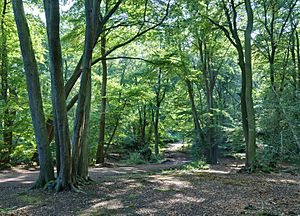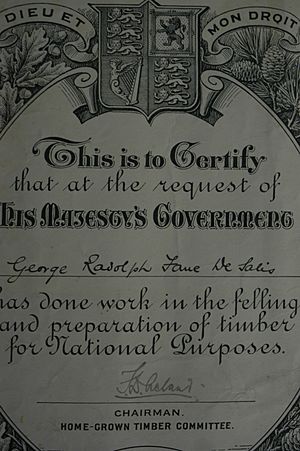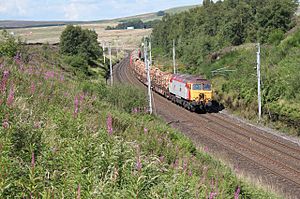Forestry in the United Kingdom facts for kids

The United Kingdom is a great place for trees to grow! It has mild winters, lots of rain, good soil, and hills that protect forests. Because of this, trees like broadleaf trees (which lose their leaves) grow faster here than in most of Europe. Conifer trees (like pines and spruces) grow even faster, three to five times quicker than in countries like Sweden or Finland. If people hadn't changed the land, most of Great Britain would be covered in big oak trees, except for Scotland.
Even though the UK is good for trees, they can still get sick from fungi, bugs, and other pests. In Wales, the group called Natural Resources Wales helps manage forests and supply timber.
Today, about 13% of Britain's land is covered in trees. This wasn't always the case. After the First and Second World Wars, there weren't many trees left because they were cut down for wood when imports were hard to get. In 1919, less than 5% of Britain was woodland. That's why the Forestry Commission was started in 1919. Its job was to grow more trees so the country would have enough wood in the future. Other European countries have much more woodland, from 25% to 72% (like Finland).
About 30% of Britain's forests are owned by the government, and 70% are privately owned. Over 40,000 people work in forestry. About half of the UK's woodlands are conifers (51%). This is higher in Scotland (74%) and lower in England (26%). Britain has 32 native tree species, and 29 of them are broadleaf trees.
Britain uses a lot of wood – at least 50 million tonnes each year! Most of this (over 75%) is softwood. Unfortunately, Britain's forests can't produce enough wood, so less than 10% of the timber used comes from home-grown trees. Paper and paper products use more than half of all the wood consumed in Britain.
In 2010, the UK government thought about selling off some of the forests owned by the Forestry Commission. Many groups disagreed strongly, and by 2011, the government decided not to sell them. Instead, they set up a group called the Independent Panel on Forestry. This group suggested that England should aim to have 15% of its land covered in forests by 2060.
Contents
Why Forests Are Important

For most of British history, people have cleared forests to create farmland. Also, the climate has changed over thousands of years, which has affected where different tree species can grow. This makes it tricky to know exactly how much forest cover there would naturally be.
For example, in Scotland, there were four main types of forest:
- Oak forests in the south.
- Scots pine forests in the Scottish Highlands.
- Hazel/oak or pine/birch/oak mixes in the north-east and south-west Highlands.
- Birch forests in the Outer Hebrides, Northern Isles, and far north.
Even at its peak, forests probably covered only about 50% of Scotland because of fires, human clearing, and animals grazing.
During the First World War, Britain's wood supply became very low. A committee suggested that Britain should increase its forest area to be more independent from foreign wood supplies. This led to the creation of the Forestry Commission in 1919.
Rules about cutting down trees were made permanent in 1951. Landowners were also given money to plant trees. By the early 1970s, a lot of new trees were being planted each year, mostly fast-growing conifers. Later, in the 1990s, more broadleaf trees were planted. By the mid-1990s, more than half of all new trees planted were broadleaf.
In 1988, new grant schemes were introduced to encourage more tree planting, especially for broadleaf trees. Programs like Community Forests and the National Forest were started. Because of these efforts, the British Isles are one of the few places in the world where the amount of forested land is actually growing!
Ancient Woodlands
Ancient woodland is a special type of forest that has been continuously wooded since the year 1600. These woodlands are very important for nature. They are usually broadleaf forests and are home to many different native plants and animals. About 20% of Britain's forested area is ancient woodland.
Threats to Trees
The biggest threats to British woodlands often come from fungi.
- For conifer trees, a major threat is White Rot Fungus (Heterobasidion annosum).
- Dutch Elm Disease is caused by fungi spread by Elm Bark Beetles.
- Acute oak decline is caused by bacteria.
- Other fungi like Nectria coccinea and Bulgaria polymorpha cause Beech bark disease.
- Nectria galligena or Pseudomonas savastanoi cause Ash canker.
- Most trees can be harmed by Honey Fungus (Armillaria mellea).
- A disease called Phytophthora ramorum (also known as "Sudden oak death" in the USA) has killed many Japanese Larch trees in the UK.
Bugs like beetles, moths, and weevils can also damage trees. Some serious ones include:
- The Large Pine Weevil (Hylobius abietis), which can kill young conifer trees.
- The Spruce Bark Beetle (Ips typographus), which can kill spruce trees.
- The Cockchafer (Melolontha melolontha), which eats young tree roots and can kill trees in dry weather.
Animals like rabbits, squirrels, voles, field mice, deer, and farm animals can also harm trees. Environmental dangers include air pollution, acid rain, and wildfires.
The Timber Industry
In 2013, the UK produced a lot of sawn wood, wood panels, and paper. However, the UK doesn't produce enough timber for its own needs, so it has to import a lot of wood and paper from other countries. In 2008, the UK imported over £1.2 billion worth of sawn wood and over £4.2 billion worth of paper products.
Around 15,000 people work in forestry in the UK, and another 26,000 work in processing wood. The timber industry adds a lot of value to the country's economy. As sawmills close, the use of wood for energy (biomass) is becoming more important for the industry's future.
Growing Healthy Trees
For successful forestry, it's important to grow healthy, well-shaped trees that can resist diseases and pests. The best wood comes from trees with straight trunks and small, evenly spaced branches. To get these results, foresters plant good quality seeds in the best possible growing conditions.
Who Manages Forests?
The Forestry Commission was set up in 1919 because there wasn't enough timber after the First World War. Back then, only 5% of Britain was covered in forests. The government wanted to make sure the country had enough wood for the future. Since then, forest cover has doubled. The Commission now also focuses on managing forests in a way that helps the environment and benefits the public. They work with the government to reach the goal of 12% forest cover by 2060.
In 2013, Natural Resources Wales took over managing forests in Wales. In Scotland, two new groups, Forestry and Land Scotland and Scottish Forestry, were created in 2019. The Forestry Commission still manages forests in England and helps with international forestry policies. They also make sure that private landowners get a license before cutting down trees.
The Forest Stewardship Council (FSC UK) sets standards for how forests are managed in the UK. They make sure that the timber industry considers the environment, people, and the economy.
Moving Timber
Most of Britain's timber is moved by road using large trucks. Since forests are often in rural areas, these heavy trucks can damage small roads, especially in the Scottish Highlands. To help with this, companies are now helping to pay for road repairs and are also using other ways to transport timber, like trains and ships. Even though many forest railways closed down in the past, more timber is now being moved by train, especially with new lines opening in places like Devon, the Pennines, Scotland, and South Wales.
Land Prices
The price of woodland has increased a lot, sometimes reaching over £10,000 per acre in 2012. This is partly because owning woodland has good tax benefits and is seen as a nice place to own for recreation.
Images for kids
-
Electricity wires cut through the forest at Coed Plas-y-Nant (Clwydian Range AONB), Ruthin, Wales





